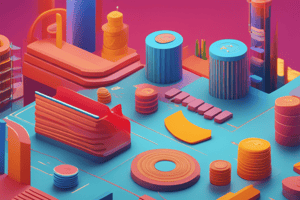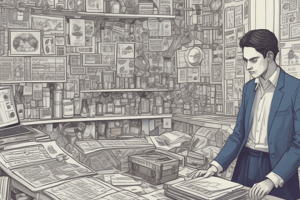Podcast
Questions and Answers
What does a mixed economy primarily combine?
What does a mixed economy primarily combine?
- Elements of socialism and aristocracy
- Elements of communism and capitalism
- Elements of feudalism and democracy
- Elements of socialism and capitalism (correct)
What is inflation primarily characterized by?
What is inflation primarily characterized by?
- A sustained increase in the general price level of goods and services (correct)
- A sustained decrease in employment levels
- A significant drop in international trade
- A sharp increase in government spending
Which of the following factors does NOT typically contribute to economic growth?
Which of the following factors does NOT typically contribute to economic growth?
- Increased taxation (correct)
- Technological advancements
- Capital investment
- Human capital development
Which type of unemployment is typically temporary and due to the transition between jobs?
Which type of unemployment is typically temporary and due to the transition between jobs?
What role does monetary policy play in economic management?
What role does monetary policy play in economic management?
What does microeconomics primarily focus on?
What does microeconomics primarily focus on?
What is the opportunity cost in economic terms?
What is the opportunity cost in economic terms?
Which of the following factors does elasticity measure?
Which of the following factors does elasticity measure?
What characterizes a monopoly market structure?
What characterizes a monopoly market structure?
Which economic system is characterized by private ownership and market-driven allocation?
Which economic system is characterized by private ownership and market-driven allocation?
What result do positive externalities typically lead to?
What result do positive externalities typically lead to?
What is meant by market failures?
What is meant by market failures?
How does productivity influence production?
How does productivity influence production?
Flashcards
Mixed Economy
Mixed Economy
A type of economy that combines elements of both capitalism and socialism, with a mix of private and public ownership, and government intervention in the market.
Inflation
Inflation
An increase in the general price level of goods and services over time, which can erode purchasing power.
Unemployment
Unemployment
The percentage of the workforce actively seeking employment but unable to find a job.
Fiscal Policy
Fiscal Policy
Signup and view all the flashcards
Monetary Policy
Monetary Policy
Signup and view all the flashcards
What is Economics?
What is Economics?
Signup and view all the flashcards
What is Microeconomics?
What is Microeconomics?
Signup and view all the flashcards
What is Macroeconomics?
What is Macroeconomics?
Signup and view all the flashcards
What is Opportunity Cost?
What is Opportunity Cost?
Signup and view all the flashcards
How do Supply and Demand work?
How do Supply and Demand work?
Signup and view all the flashcards
What are Market Structures?
What are Market Structures?
Signup and view all the flashcards
What is Elasticity?
What is Elasticity?
Signup and view all the flashcards
What is Productivity?
What is Productivity?
Signup and view all the flashcards
Study Notes
Introduction to Economics
- Economics is the social science studying how societies allocate scarce resources to satisfy unlimited wants and needs.
- Two main branches are microeconomics and macroeconomics.
- Microeconomics examines individual markets, consumers, producers, and their interactions.
- Macroeconomics analyzes the entire economy, including inflation, unemployment, and economic growth.
Scarcity and Choice
- Resources are scarce, insufficient to satisfy all desires.
- Scarcity necessitates choices about resource use.
- Choices involve trade-offs.
- Opportunity cost is the value of the next best alternative forgone.
Basic Economic Concepts
- Supply and Demand: Interaction of supply and demand determines market price and quantity. Supply is the quantity producers offer at various prices, while demand is the quantity consumers wish to buy. Equilibrium occurs where supply and demand curves intersect.
- Market Structures: Markets vary, with examples including perfect competition, monopolies, and oligopolies. Each structure affects pricing, output, and market dynamics.
- Elasticity: Measures responsiveness of quantity demanded or supplied to price or other factors. This includes price elasticity of demand, price elasticity of supply, income elasticity of demand, and cross-price elasticity of demand.
- Productivity: Measures production efficiency. Increased productivity yields greater output with the same resources.
- Externalities: Unintended market consequences affecting third parties. Positive externalities benefit and negative externalities harm third parties, such as education and pollution, respectively.
- Market Failures: Markets sometimes fail to allocate resources efficiently. Externalities and information asymmetries are common causes. Government intervention might be needed to correct this.
Economic Systems
- Capitalism: Private ownership of resources, market allocation, profit motive.
- Socialism: Social ownership, centralized planning, aiming for equitable distribution.
- Mixed Economy: Combines capitalist and socialist aspects. Most modern economies are mixed.
Macroeconomic Issues
- Economic Growth: Measured by increases in real GDP. Factors include capital investment, technological progress, and human capital.
- Inflation: Sustained increase in general price levels. Causes range from increased demand to supply-side issues.
- Unemployment: Portion of labor force actively seeking work but unemployed. Types include frictional, structural, and cyclical unemployment.
- Fiscal Policy: Government policies affecting taxation and spending to influence the economy.
- Monetary Policy: Actions by central banks managing money supply and credit to promote stability. Interest rates and reserve requirements are common tools.
- Economic Fluctuations: Recessions and expansions, assessed via GDP growth, employment, and inflation. Economists study these for better understanding and management.
International Economics
- Trade: Exchange of goods and services between countries. Factors include comparative advantage, specialization, and international agreements (e.g., WTO).
- Exchange Rates: Relative value of one currency to another, fluctuating and affecting international trade and investment.
- Globalization: Increasing interconnectedness of economies through trade, investment, and technology.
Studying That Suits You
Use AI to generate personalized quizzes and flashcards to suit your learning preferences.




